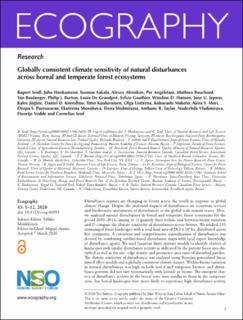Globally consistent climate sensitivity of natural disturbances across boreal and temperate forest ecosystems
Seidl, Rupert; Honkaniemi, Juha; Aakala, Tuomas; Aleinikov, Alexey; Angelstam, Per; Bouchard, Mathieu; Boulanger, Yan; Burton, Philip J.; De Grandpré, Louis; Gauthier, Sylvie; Hansen, Winslow D.; Jepsen, Jane Uhd; Jõgiste, Kalev; Kneeshaw, Daniel D.; Kuuluvainen, Timo; Lisitsyna, Olga; Makoto, Kobayashi; Mori, Akira S.; Pureswaran, Deepa S.; Shorohova, Ekaterina; Shubnitsina, Elena; Taylor, Anthony R.; Vladimirova, Nadezhda; Vodde, Floortje; Senf, Cornelius
Peer reviewed, Journal article
Published version

Åpne
Permanent lenke
https://hdl.handle.net/11250/2654979Utgivelsesdato
2020Metadata
Vis full innførselSamlinger
- Publikasjoner fra CRIStin - NINA [2364]
- Scientific publications [1392]
Sammendrag
Disturbance regimes are changing in forests across the world in response to global
climate change. Despite the profound impacts of disturbances on ecosystem services
and biodiversity, assessments of disturbances at the global scale remain scarce. Here,
we analyzed natural disturbances in boreal and temperate forest ecosystems for the
period 2001–2014, aiming to 1) quantify their within- and between-biome variation
and 2) compare the climate sensitivity of disturbances across biomes. We studied 103
unmanaged forest landscapes with a total land area of 28.2 × 106 ha, distributed across
five continents. A consistent and comprehensive quantification of disturbances was
derived by combining satellite-based disturbance maps with local expert knowledge
of disturbance agents. We used Gaussian finite mixture models to identify clusters of
landscapes with similar disturbance activity as indicated by the percent forest area disturbed
as well as the size, edge density and perimeter–area-ratio of disturbed patches.
The climate sensitivity of disturbances was analyzed using Bayesian generalized linear
mixed effect models and a globally consistent climate dataset. Within-biome variation
in natural disturbances was high in both boreal and temperate biomes, and disturbance
patterns did not vary systematically with latitude or biome. The emergent clusters
of disturbance activity in the boreal zone were similar to those in the temperate
zone, but boreal landscapes were more likely to experience high disturbance Activity
than their temperate counterparts. Across both biomes high disturbance activity was particularly associated with wildfire, and was consistently linked to years with warmer and drier than average conditions. Natural disturbances are a key driver of variability in boreal and temperate forest ecosystems, with high similarity in the disturbance patterns between both biomes. The universally high climate sensitivity of disturbances across boreal and temperate ecosystems indicates that future climate change could substantially increase disturbance activity.
